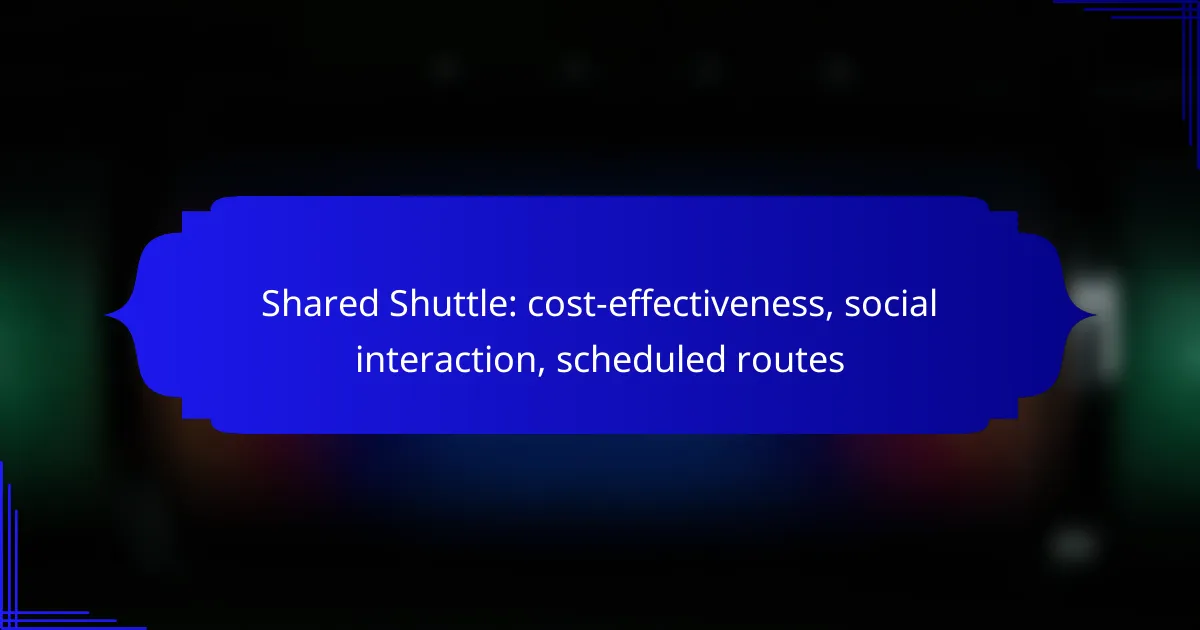Shared shuttles offer a cost-effective transportation solution in urban areas, providing a more affordable alternative to traditional taxis. Beyond their economic benefits, these shuttles foster social interaction among passengers, enriching the travel experience. Operating on scheduled routes, they connect major destinations, making them a convenient choice for both commuters and travelers.
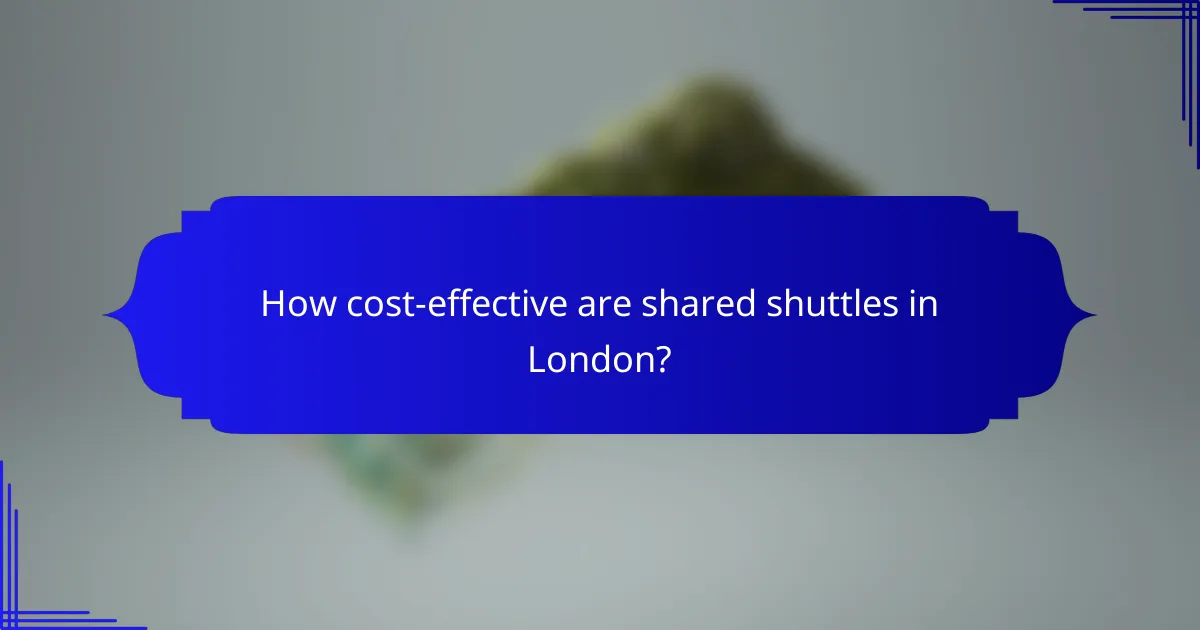
How cost-effective are shared shuttles in London?
Shared shuttles in London are a cost-effective transportation option, often significantly cheaper than traditional taxis. They provide an economical way to travel while also allowing for social interaction among passengers.
Lower fares compared to taxis
Shared shuttles typically offer lower fares than taxis, making them an attractive choice for budget-conscious travelers. While taxi fares can vary widely based on distance and time of day, shared shuttle prices are generally fixed and can be considerably lower, often ranging from £10 to £30 for similar routes.
This pricing structure allows passengers to save money, especially when traveling longer distances or during peak hours when taxi rates increase. By opting for a shared shuttle, you can enjoy significant savings while still reaching your destination efficiently.
Group discounts available
Many shared shuttle services in London offer group discounts, making them even more affordable for larger parties. These discounts can reduce the cost per person, encouraging friends or family to travel together.
For example, a group of four might pay £25 each for a shuttle, but with a 20% group discount, the fare could drop to £20 each, resulting in a total savings of £20 for the group. Always check with the shuttle provider for specific group discount policies and availability.
Cost per passenger analysis
When analyzing the cost per passenger for shared shuttles, it’s essential to consider both the total fare and the number of passengers. The more people sharing the ride, the lower the individual cost becomes.
For instance, if a shared shuttle costs £40 and accommodates up to eight passengers, the cost per passenger is just £5. This model not only makes travel affordable but also promotes social interaction, as passengers can meet and converse during their journey.
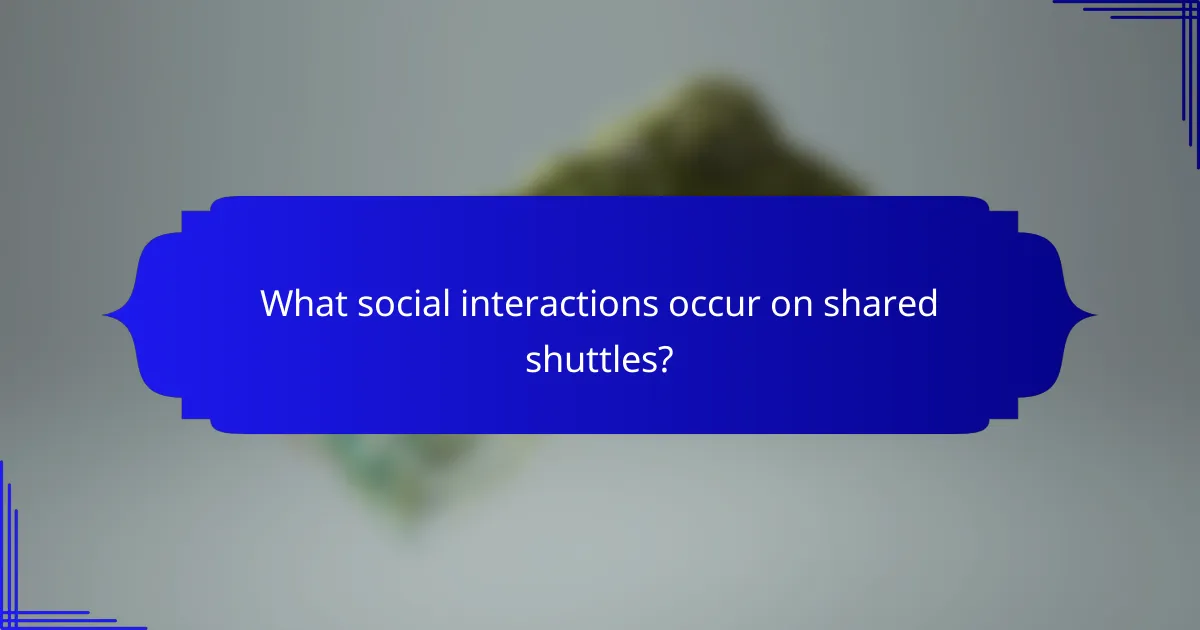
What social interactions occur on shared shuttles?
Shared shuttles facilitate various social interactions among passengers, enhancing the travel experience. These interactions can range from casual conversations to meaningful connections, often influenced by the shared journey and environment.
Opportunities for networking
Shared shuttles provide a unique platform for networking, especially in urban areas or during events. Passengers often come from diverse professional backgrounds, making it easy to exchange ideas and contact information. Engaging in conversation can lead to potential collaborations or job opportunities.
To maximize networking, consider sitting near others and initiating discussions about common interests or experiences. Carrying business cards can also be beneficial for quick exchanges.
Community building among passengers
Community building occurs naturally on shared shuttles as passengers share a common goal of reaching a destination. This shared experience fosters a sense of belonging and camaraderie, particularly among regular riders. Over time, familiar faces can lead to friendships and a supportive community atmosphere.
Participating in group discussions or sharing local tips can enhance this sense of community. Consider joining shuttle services that promote social interaction among riders to strengthen these connections.
Shared experiences and conversations
Traveling together creates shared experiences that can spark conversations among passengers. Topics may include travel tips, local attractions, or even personal stories, making the journey more enjoyable. These interactions can break the ice and make the ride feel shorter.
To encourage engaging conversations, be open and approachable. Asking open-ended questions can lead to more meaningful exchanges and help build rapport with fellow passengers.
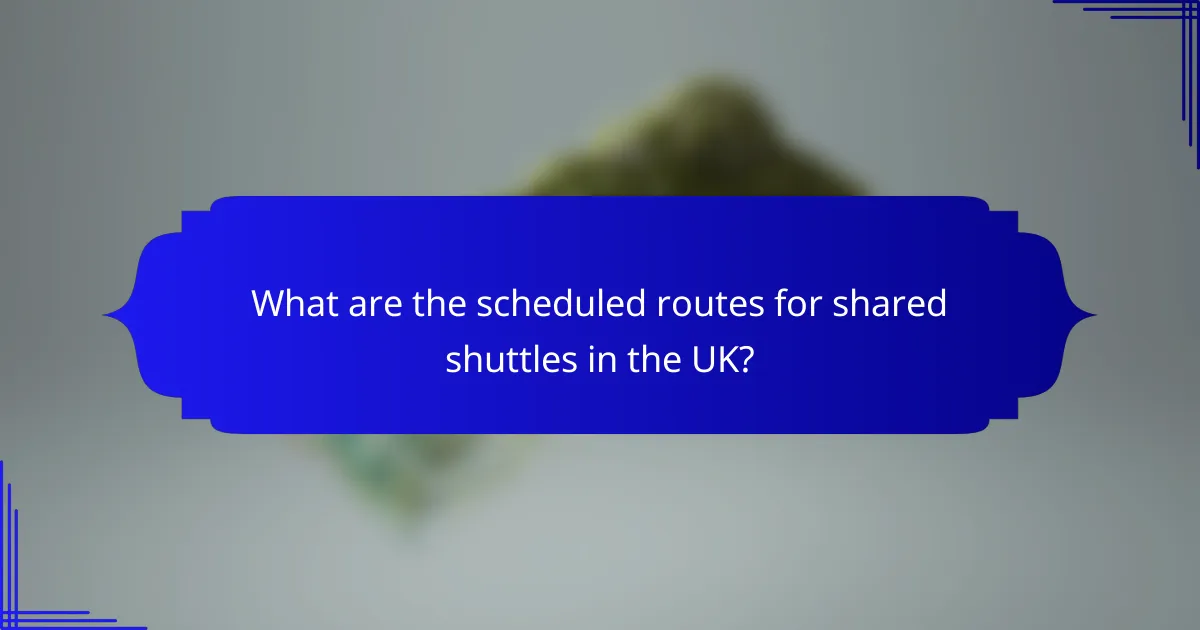
What are the scheduled routes for shared shuttles in the UK?
Shared shuttles in the UK operate on a variety of scheduled routes, connecting major urban areas and popular destinations. These routes are designed to provide convenient and cost-effective transportation options for commuters and travelers alike.
Popular routes in major cities
In cities like London, Manchester, and Birmingham, shared shuttles frequently connect key locations such as airports, train stations, and business districts. For example, routes may link Heathrow Airport with central London or connect Manchester city center with nearby suburbs.
Other popular routes include connections between major universities and city centers, catering to students and staff. These shuttles often run during peak hours to accommodate high demand.
Frequency of service
Shared shuttle services typically operate at regular intervals, often ranging from every 15 to 30 minutes during peak times. Off-peak services may have longer wait times, sometimes extending to an hour.
It’s advisable to check specific schedules in advance, as frequency can vary based on the day of the week and local events. Some services may offer reduced frequency during weekends or holidays.
Real-time tracking options
Many shared shuttle services in the UK provide real-time tracking through mobile apps or websites, allowing passengers to monitor shuttle locations and estimated arrival times. This feature enhances convenience and reduces uncertainty for travelers.
Users can typically receive notifications about delays or changes in service, ensuring they can plan their journeys more effectively. It’s recommended to download the relevant app or check the service’s website for the most accurate information.
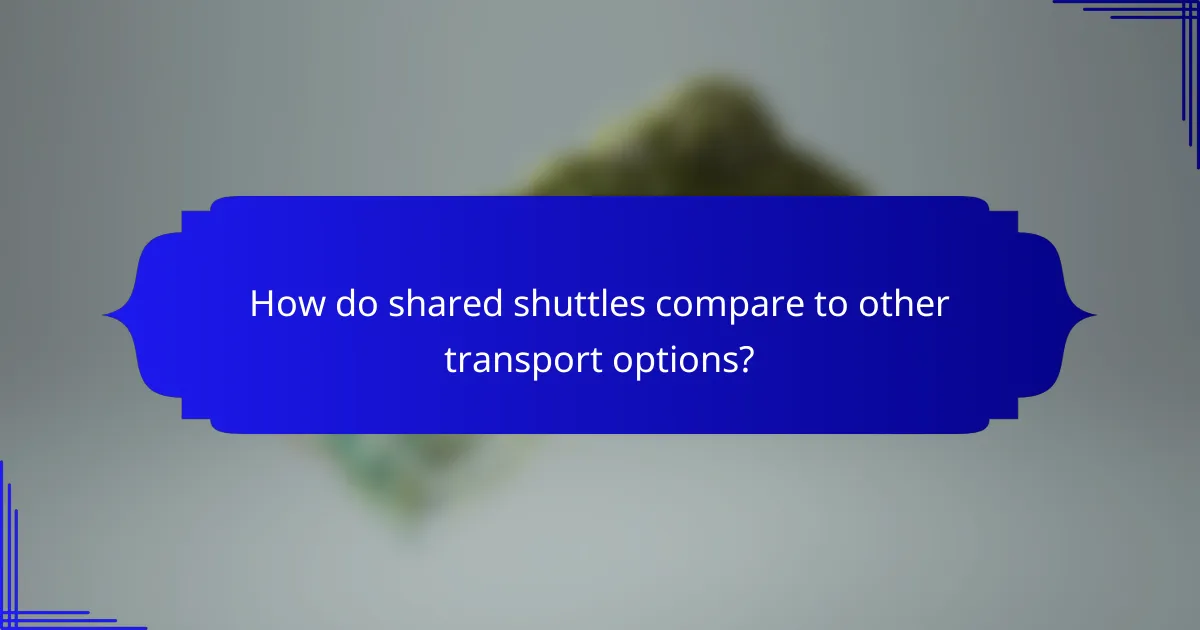
How do shared shuttles compare to other transport options?
Shared shuttles offer a cost-effective and socially engaging alternative to various transport options, balancing affordability with convenience. They typically operate on scheduled routes, making them a reliable choice for commuters and travelers alike.
Comparison with public transport
Shared shuttles often provide a more direct and comfortable experience compared to public transport. While buses and trains may have multiple stops and longer travel times, shuttles can reduce travel duration significantly, especially during peak hours.
In terms of cost, shared shuttles can be slightly more expensive than standard public transport fares, but they often offer group discounts or subscription plans that can make them more economical for regular users. For instance, a shuttle ride might range from $5 to $15, depending on the distance and service level.
Comparison with ride-sharing services
Unlike ride-sharing services that charge per trip and can become costly, especially for longer distances, shared shuttles typically operate on a fixed fare system. This can lead to substantial savings for users who travel frequently or in groups.
Moreover, shared shuttles foster social interaction by accommodating multiple passengers, whereas ride-sharing often focuses on individual trips. This communal aspect can enhance the travel experience, making it more enjoyable and less isolating.
Environmental impact analysis
Shared shuttles can significantly reduce carbon emissions per passenger compared to individual car trips or ride-sharing vehicles. By consolidating multiple passengers into a single vehicle, shuttles help decrease the number of cars on the road, contributing to lower traffic congestion and pollution levels.
Many shuttle services are also adopting eco-friendly practices, such as using electric or hybrid vehicles, which further minimizes their environmental footprint. Choosing a shared shuttle over other transport options can be a responsible choice for environmentally conscious travelers.
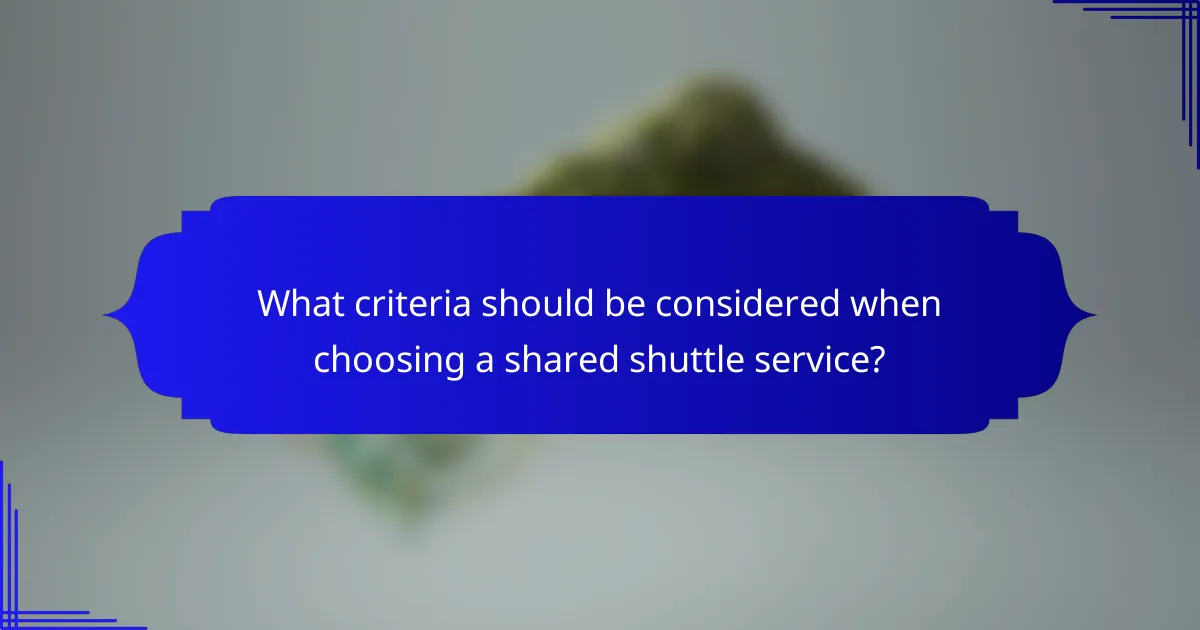
What criteria should be considered when choosing a shared shuttle service?
When selecting a shared shuttle service, focus on pricing structures, service reliability, and customer reviews. These factors will help you determine the best option for your travel needs and budget.
Pricing structures
Pricing for shared shuttle services can vary significantly based on distance, time of day, and the number of passengers. Typically, fares range from a few dollars to around fifty dollars per trip, depending on the route and service provider.
Some companies offer flat rates for specific routes, while others may charge per mile or per passenger. It’s essential to compare these structures to find the most cost-effective option for your journey.
Service reliability
Reliability is crucial when choosing a shared shuttle service. Look for providers that have a reputation for punctuality and consistent service. Check if they offer real-time tracking and updates, which can enhance your travel experience.
Consider the frequency of scheduled routes as well. Services that run regularly throughout the day will provide more flexibility and reduce wait times, making your travel smoother.
Customer reviews and ratings
Customer feedback is a valuable resource when evaluating shared shuttle services. Look for reviews on platforms like Google or travel forums to gauge the experiences of other travelers.
Pay attention to ratings regarding cleanliness, driver professionalism, and overall satisfaction. A service with consistently high ratings is likely to provide a better travel experience than one with mixed reviews.
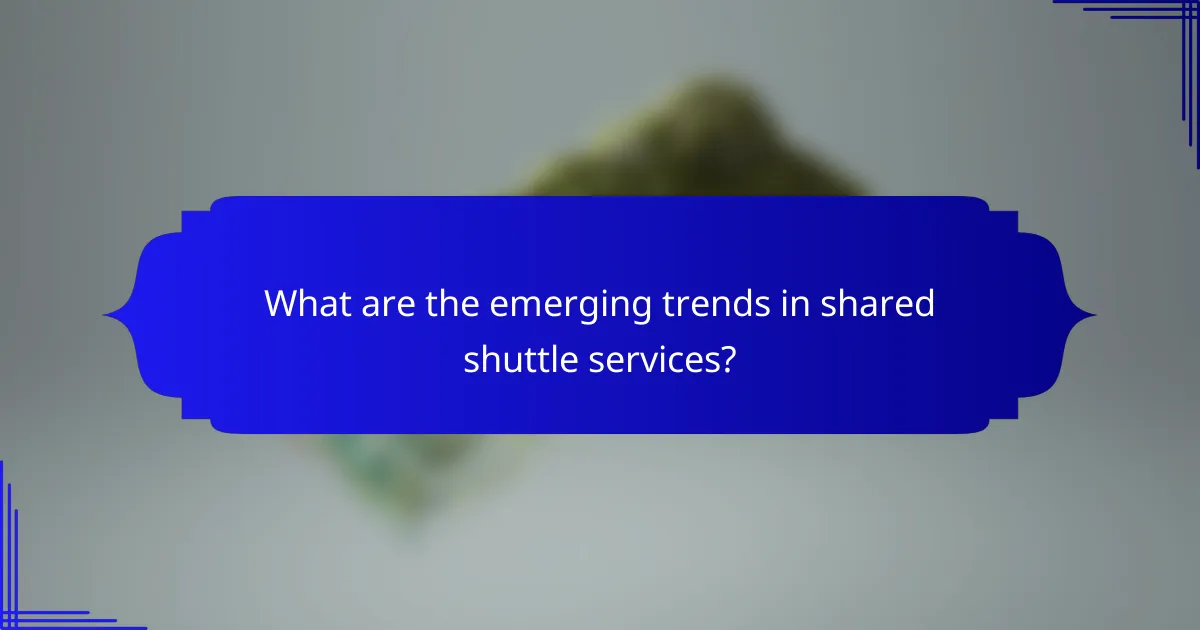
What are the emerging trends in shared shuttle services?
Emerging trends in shared shuttle services focus on enhancing user experience, sustainability, and operational efficiency. Key developments include the integration of mobile apps, the rise of eco-friendly shuttle options, and a growing demand for flexible scheduling to meet diverse passenger needs.
Integration with mobile apps
Mobile apps are becoming essential for shared shuttle services, allowing users to book rides, track vehicles in real-time, and make payments seamlessly. These applications often provide features like route optimization and estimated arrival times, enhancing convenience for passengers.
For instance, many services now offer user-friendly interfaces that allow for easy ride sharing with friends or colleagues, promoting social interaction and reducing costs. When choosing a shuttle service, check if they have a dedicated app and read user reviews to assess its functionality.
Expansion of eco-friendly shuttles
There is a noticeable shift towards eco-friendly shuttles, with many companies investing in electric or hybrid vehicles to reduce their carbon footprint. This trend not only appeals to environmentally conscious consumers but can also lead to lower operational costs over time.
In urban areas, these green shuttles often qualify for government incentives or subsidies, making them a cost-effective option for service providers. When considering a shuttle service, inquire about their vehicle types and sustainability practices to support eco-friendly options.
Increased demand for flexible scheduling
Passengers are increasingly seeking flexible scheduling options that accommodate their varying travel needs. This trend is driven by the desire for convenience and the need to adapt to last-minute changes in plans.
Many shuttle services are now offering on-demand rides, allowing users to book a shuttle with minimal notice. When evaluating services, look for those that provide flexible scheduling and consider peak times to avoid longer wait periods or crowded shuttles.
